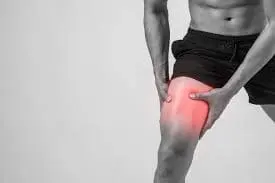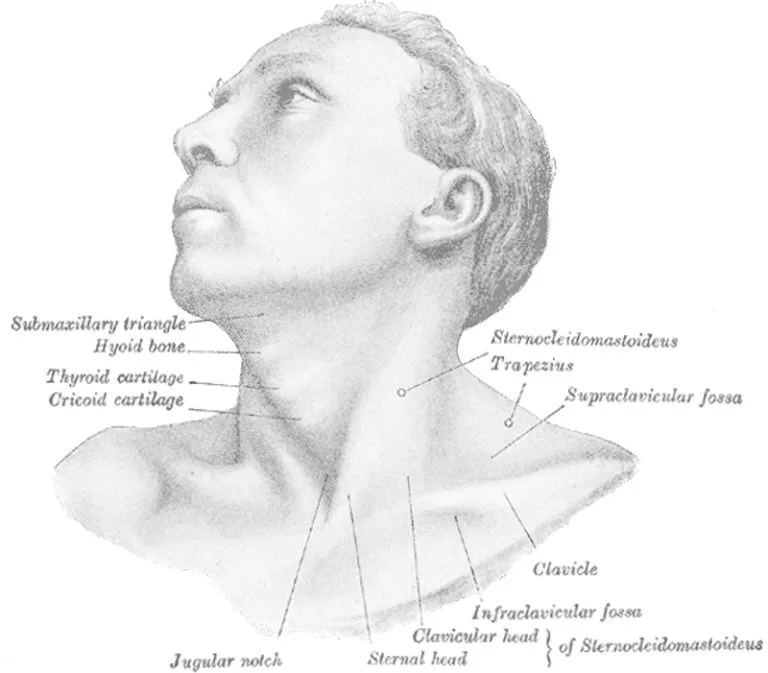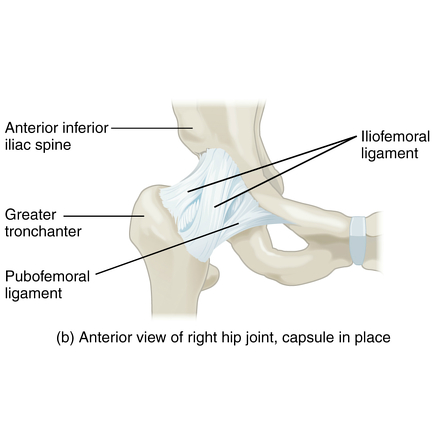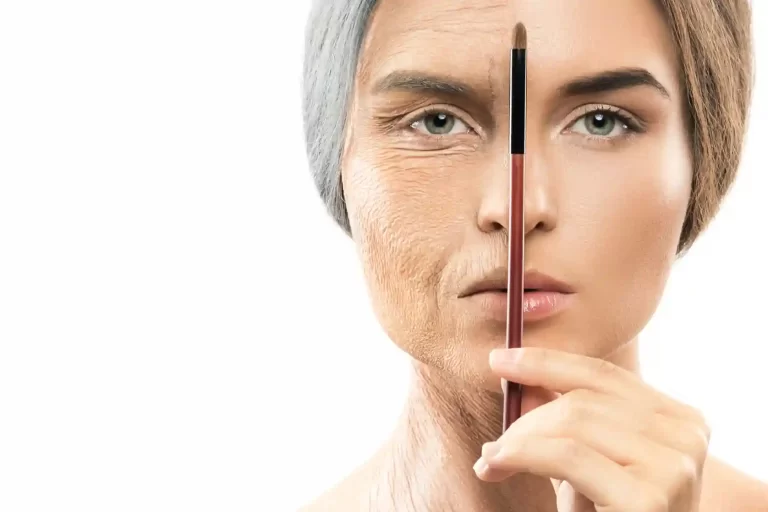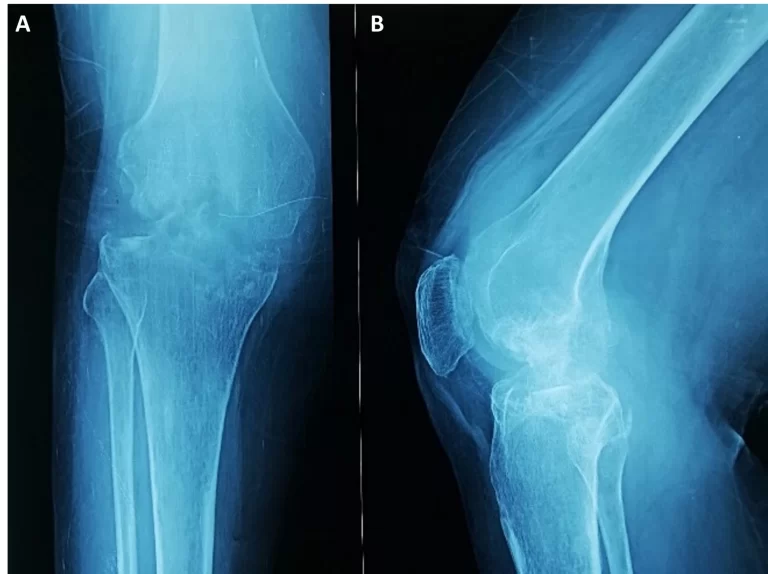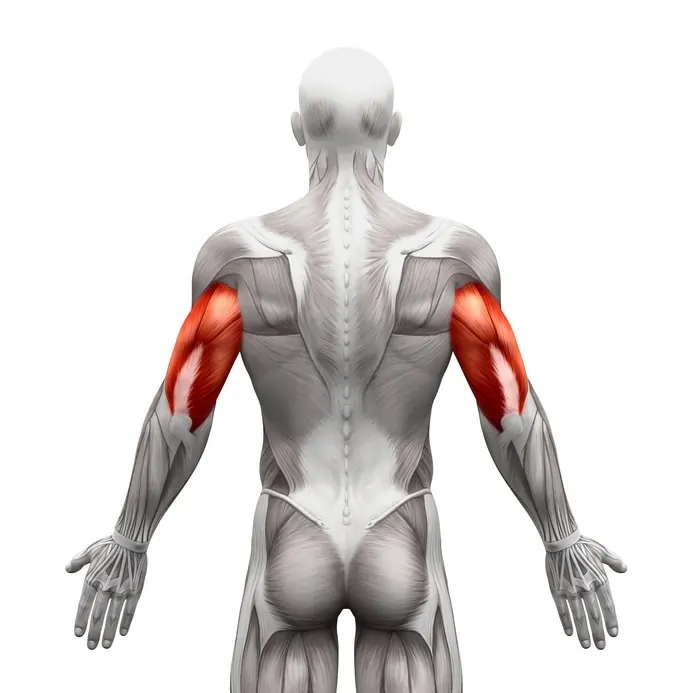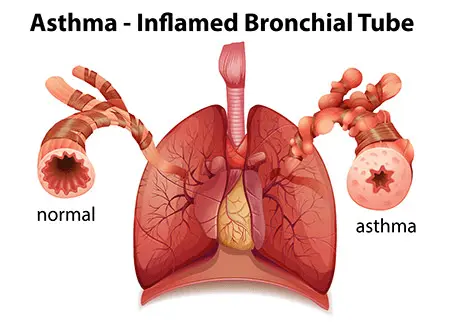Muscle Pain in the Thigh
If you experience difficulty running, walking, or climbing stairs as a result of thigh pain, you may have Thigh muscle pain. There are far too many reasons for this pain in the muscles of the thighs, such as trauma and injury.
There are times, just when it happens for unclear reasons. Additionally, you have tingling, numbness, and weakness in your thigh. Medication, the rice principle, and physical therapy treatments all help alleviate this pain.
What parts make up the thigh?
The portion of the upper leg that is between the hip and knee joints is called the thigh.
The thigh is made up of various sections, including;
- The muscles in the front of the thigh that make up the quadriceps come first. It’s meant allowing you to bend at the hip joint and straighten your knee.
- The hamstring muscles are found on the rear of the thigh, which can bend to meet the knee.
- The pelvic muscles are found on the inside of the thigh and are responsible for pulling the leg toward the abdomen.
- The gluteus medius is one of the hip muscles that pull the thigh out to the side.
Causes for Thigh muscle pain:
- Spinal Stenosis
This ailment is thought to be a degenerative one that becomes worse with time. It usually appears in those over 40. This condition arises from compression of the spinal nerves by the spine’s bones. It is an effect of the wear and tear that comes with living a regular life.
- Compressed spinal nerve
Thigh pain results from the body’s reaction to both herniated lumbar discs and low back arthritis, which press on the nerves that exit the spinal column and travel down the thigh.
- Trauma
Due to the large number of muscles and nerves located in the thigh, any type of physical hit to the thigh causes extreme pain.
- Hamstring and quadriceps tendinitis
The thigh muscles become inflamed in the tendons when they are used excessively and repeatedly. Thigh muscle inflammation and pain are symptoms of tendinitis.
- A stroke
Blunt pain in the thigh might occasionally result from a brain vascular event (stroke).
- Blood Clot
Heel pain, warmth, swelling, and redness are symptoms of a blood clot in the lower leg or thigh.
- Deep vein thrombosis
This is a condition that most commonly results in deep vein clots in the lower legs, which also hurt the thighs.
- Injury to the muscles
Sprains and strains are examples of muscle injuries that are increasingly common reasons for upper thigh pain. The pain in this area is caused by a muscle injury since the upper thigh has a very large number of muscles.
- A sedentary way of life
Pain that lasts longer results from damaging your muscles from sitting for extended periods each day and not getting enough exercise. Long periods of sitting put strain on the muscles and joints, especially the legs and hips. Muscle weakness and diffused muscle pain are caused by inactivity in the legs.
Individuals who have had pain in their upper thighs due to prolonged periods of inactivity say they experience pain throughout their whole body.
- Chronic conditions
Upper thigh pain is a contributing factor to many chronic diseases. If the patients have fibromyalgia, which is characterized by constant, all-over pain at particular pressure spots.
- Overuse injuries
When a person does not warm up before exercising or works a muscle in or around the thigh too hard for too long, overuse problems may result. As time passes, the pain usually gets worse. After a while, the pain could continue even if the damaged area is rested.
The basic sign of Pain following exercise or vigorous physical activity is a reliable indicator of an overuse injury. Maybe both thighs are hurting.
Diabetic neuropathy is an outcome of diabetes that arises from uncontrolled hyperglycemia. Though it can sometimes extend to other areas of the body, such as the thighs, it usually starts in the hands or feet.
Although diabetic neuropathy has no known cure, lifestyle modifications, blood sugar control techniques, and painkillers can all be used to manage pain and other symptoms.
- Iliotibial Band Friction Syndrome
The thick band of tissue that extends from the top of your shinbone to the outside of your thigh is called the iliotibial band, or IT band.
The iliotibial band can occasionally get stiffer as a result of abuse or ongoing stress (like long-distance running).
Iliotibial Band Friction Syndrome pain typically gets better with rest and gets worse with increased exercise. Physical therapy helps many people learn stretches and strengthening exercises for their Iliotibial Band Friction Syndrome.
Signs and symptoms of Thigh muscle pain:
- Both the front and back of your thigh hurt.
- Observed redness and swelling where there is pain.
- Additionally, there are currently tightness and spasms in the painful area.
- Also, you have tingling and numbness in your thigh.
- Muscle weakness in the thighs.
- You have pain when sitting and getting up from a seated position.
- Further, you have trouble with wall squats, leg lifts, and walking.
- Similarly, it appears that you are developing in the painful area.
- There is also a burning feeling where there used to be pain.
Which condition are you going to see a doctor for?
While some people with thigh pain may manage it on their own, others need to see a doctor almost away.
Among the warning signs and symptoms that call for an appointment to the doctor are:
- Being in excruciating pain makes it difficult for you to function.
- When your pain makes it difficult for you to walk normally.
- This pain is an indication of an infection when it exists with a fever and exhaustion.
- If you have thigh pain that is followed by skin that is heated, swollen, and red.
- It could be a blood clot and you should get treatment right away.
- A visit to an orthopedic surgeon is necessary to effectively evaluate and treat conditions resulting from muscle strains and tears that cause the thigh to seem irregular.
- See an orthopedic specialist who has looked into this disease if you have sudden, excruciating pain in your legs that is caused by a pinched nerve in your back.
When experiencing any of the following symptoms, you need to get medical careful consideration:
- Bluish or clammy skin
- Losing consciousness
- Anxiety
- Irregular cardiac rhythm
- Restlessness
- Weak pulse
- Breathlessness
- Pain radiating from the chest into the mouth, arm, neck, and shoulder
Diagnosis of the Thigh muscle Pain:
The doctor needs to see you and complete an evaluation as soon as you call.
- The first doctor tried to find out the cause of the pain by inquiring about it.
- The area of observation includes changes in color, redness, and swelling at the location of pain.
- Palpate for edema and spasms throughout the palpation phase.
- In the examination section, look at the thigh muscle’s strength and range of motion.
- The doctor recommended suitable treatment for the muscle pain following that evaluation.
Additionally, the doctor recommended the following diagnostic tests for diagnosis:
- X-ray:
This diagnostic procedure examines the thigh, knee, and hip joint bones to check for arthritis and fractures, which could be the source of the pain.
- Test for electromyography (EMG):
The purpose of the EMG examination is to evaluate the thigh’s nerve function.
This test additionally reveals a pinched nerve and a lack of nerve function.
- Magnetic resonance imaging (MRI):
Images of the soft tissue surrounding the thigh are displayed using this test.
It also assesses the degradation of tendons and muscles.
- Ultrasonography:
This examination helps you see the veins and arteries surrounding the thigh.
The blood clot is also examined during this procedure.
- Joint aspiration:
It is a process that includes removing fluid from a joint and looking for particular issues with the joint.
Treatment for Thigh muscle pain:
Pain relievers
- To relieve pain in the muscles, your doctor has also recommended an anti-inflammatory medication, primarily NSAIDs like Advil or ibuprofen, as well as an anti-inflammatory cream like Aspercreme.
- The doctor recommended Tylenol, which contains acetaminophen, to relieve the inflammation.
- Rest: When muscle pain first appears, the doctor usually advises resting for a few days and avoiding activities that aggravate the thigh pain. Walking, on the other hand, is a common way to cure thigh pain.
- Ice: Applying ice directly to the area of pain for 15 to 20 minutes can also help reduce pain and swelling. You can also apply an ice pack and preserve it in the freezer pods to relieve pain, but this should be done with a cloth placed between the ice and the skin to prevent skin redness.
- Compression: To relieve swellings, you can also apply a compression bandage to the area that hurts.
- Elevation: Using foot support, you can raise the leg and reduce swelling.
Treatment with physiotherapy for pain in the thigh muscles:
Massage therapy
- Through increased circulation, lowered stress, and the smoothing out of muscular knots, this therapy helps to relieve thigh pain.
- Using powder and oil, this massage is given for five to ten minutes on the muscle’s sensitive and trigger points.
Treatment using electrotherapy:
Ultrasound therapy (US)
- The therapy is applied to the area of pain for five to ten minutes while using gel.
- This treatment helps in pain and swelling relief.
Short wave diathermy (SWD)
- SWD is an effective treatment that reduces spam instead of pain.
Interferential Current Therapy and Transcutaneous Electrical Nerve Stimulation:
- IFC and TENs are applied to the painful location using gel and electrodes.
- The pain spot is treated with this therapy for ten to fifteen minutes.
Stretching exercise:
You can relieve muscle pain and tightness by stretching your muscles.
Hip Flexor Stretch
- On a yoga or fitness mat, bend both of your knees.
- Your feet should be firmly placed into the mat with your bottom on the heel of your feet.
- Press your palms to the mat while bending forward.
- Bend your elbows slightly while maintaining your hands shoulder-width apart to prevent your elbows from locking.
- Using the space between your arms, bring your left knee forward and plant your left foot flat on the mat in front of you to form a 90-degree angle.
- For stability and balance, raise the upper part of your body straight and rest both hands on your left knee in front of you.
- Lift and extend your right leg in the direction towards you.
- With the top of your right foot resting on the mat, your right knee should be forced into the surface.
- To make the stretch deeper, lean forward a little.
- Hold this posture for a few seconds.
- Then return to your neutral position.
- Then relax.
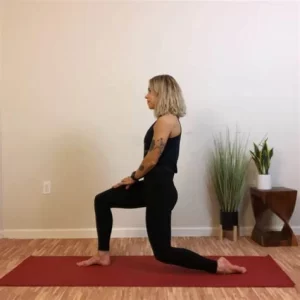
Standing Hamstring Stretch
- The person should stand straight, lean over, and try to touch their toes while maintaining a straight knee joint.
- And make an effort to keep going straight until you feel a slight stretch behind your knees.
- Hold this position for a few seconds.
- Then return to your neutral position.
- Then relax.
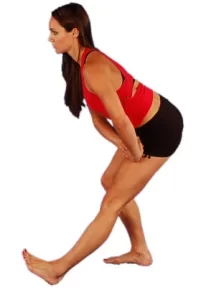
Shin Stretch
- Starting from a kneeling position, carefully sit down until your knees are in front of you and your heels are just under your glutes.
- Lean back a little while placing your hands on your thighs.
- Put a small amount of your body weight on your heels when you feel the stretch.
- To apply more pressure, raise your knees just a little bit off the ground.
- Hold this position for a few seconds.
- Then return to your neutral position.
- Then relax.
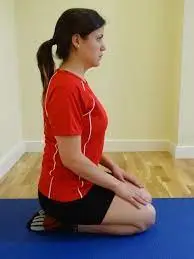
Standing Quadriceps Stretch
- Begin in a comfortable standing posture on the ground.
- Hold onto something solid, such as a chair or wall, if you need support.
- Pull your heel up to your buttocks while bending your right knee.
- Use the hand on your left side to reach for your ankle.
- Stand upright and contract your abdominal muscles.
- Make an effort to keep your knees close together.
- Let your shoulders relax.
- You should feel a slight push along the front of your thigh and hip while you maintain your leg bent.
- Hold this position for a few seconds.
- Then return to your neutral position.
- Then relax.
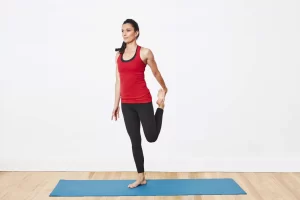
Seated Hamstring Stretch
- Sit on a chair with your back straight and close to the edge of the seat.
- Place the other leg on a chair and extend it out in front of you.
- Bend the body forward gradually until the back of the thigh is stretched.
- Make sure the shoulders don’t droop forward and the spine is in a neutral position.
- Hold this position for a few seconds.
- Then return to your neutral position.
- Then relax.
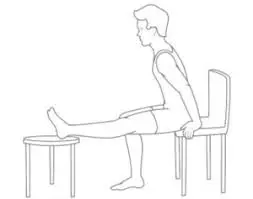
Adductor Stretch
- For the stretch, individuals should stand straight and spread their legs shoulder-distance apart.
- Next, bend your right knee and gradually lean to the right.
- It is necessary to maintain the left leg straight.
- Hold this posture until the inner left thigh begins to gently stretch.
- Then return to your neutral position.
- Then relax.
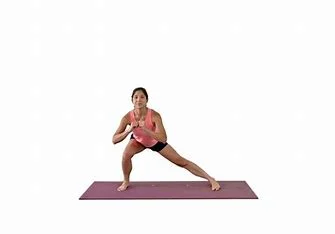
Standing calf stretch
- Keep your distance from the wall at an arm’s width.
- With your hands shoulder-width apart, lean forward and place them on the wall.
- Stretch out the side of your foot that needs to be stretched, keeping one heel on the ground and the other foot closer to the wall.
- You should feel a stretch in the leg’s extended calf when you lean your hips against the wall.
- Hold this posture for a few seconds.
- Then return to your neutral position.
- Then relax.
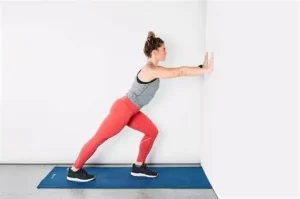
Lying Hamstring wall Stretch
- With your back flat and your legs fully stretched, take a position on the ground.
- You should also position yourself close to a doorway or wall corner for this portion.
- Lift your right leg and plant your heel on the wall, bending the knee slightly.
- Stretch your hamstrings by slowly straightening your right leg.
- Hold this position for a few seconds.
- Then return to your neutral position.
- Then relax.
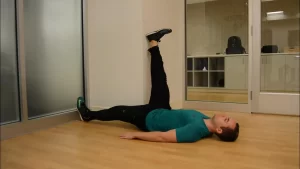
Prone Quad Stretch
- Place your legs hip-width apart and begin lying down on the floor.
- Pull your heel in the direction of your buttocks while bending one knee and reaching back to grip your ankle (or, if you are unable to reach, grab the strap around your ankle).
- Your quadriceps, or the front of your thigh, should feel stretched.
- In case you’re not experiencing much of a stretch, consciously lower your lower back towards the ground.
- You can push your heel to the outside of your hip and press your foot toward the floor (only if it feels good on your knee!)
- Hold this position for a few seconds.
- Then return to your neutral position.
- Then relax.
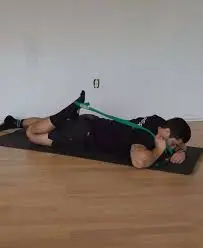
Butterfly stretch
- Legs extended in front of you, sit on the ground or floor surface.
- Grip your right foot while moving forward.
- Flexing your knee might help to strengthen the bond between your hand and foot.
- You can achieve a comfortable position by gently pulling your right foot up near your belly button and bending it over the sole face of your left thigh.
- Move your hands down to your feet and your elbows down to your knees.
- Keeping your back straight and your knees sliding toward the floor,
- You can apply moderate pressure to the knees by gently pressing with the elbows.
- You should have a small pulling sensation in your abdomen.
- Hold this position for a few seconds.
- Then return to your neutral position.
- Then relax.
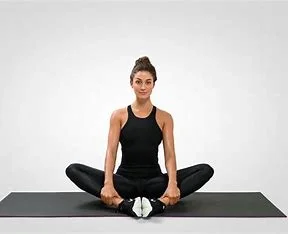
Crossover stretch
- You should be lying down with your arms out to the side and your legs straight.
- With your opposite hand on your knee, flex one knee toward your chest.
- You should feel a small stretch as you slowly bring your knee across your body and toward the ground.
- Hold this position for a few seconds.
- Then return to your neutral position.
- Then relax.
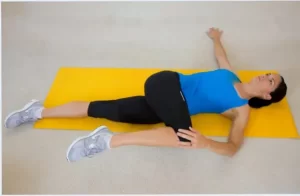
Supine Adductor Stretch with Strap
- With both knees bent and feet flat on the ground, the patient is positioned on his or her back.
- Grasp up the stretch strap and wrap it around the toe ball of the leg you wish to extend.
- Using the other hand, hold onto this strap.
- If the hamstrings are excessively tight, straighten the knee towards the ceiling and adjust the angle as necessary.
- Maintaining the inner thigh pointed upward to the ceiling, allows the leg to slide as much as possible to sideways and toward the floor.
- With the strap providing support, extend the leg until you feel a significant inner thigh stretch.
- Hold this position for a few seconds.
- Then return to your neutral position.
- Then relax.
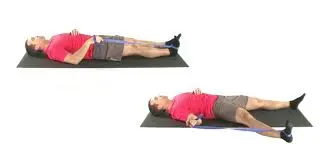
Seated Figure Four Stretch
- The patient is seated with proper posture and comfort in a chair close to the edge.
- Choose the patient’s hip joint to stretch first, then raise that leg’s ankle towards the opposing knee joint.
- Next, place the outside edge of the ankle close to the knee joint on the other thigh.
- After allowing the patient to go down as far as they are comfortable, slowly tilt the upper knee joint forward until the patient feels a deep stretch in the piriformis muscle of their buttocks.
- Hold this position for a few seconds.
- Then return to your neutral position.
- Then relax.
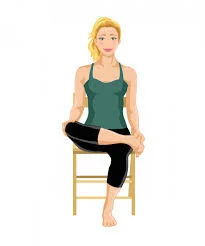
Strengthening Exercise:
Pain and weakness in the muscles can be relieved with exercise.
Hip Adduction in Side Lying
- Lay on your left side on the mat or the floor with both legs straight.
- Bend and cross your right leg over your left, keeping your right foot flat on the floor and your right knee pointing toward the ceiling.
- Place your left hand below your head and your right hand on the ground in front of you.
- Raise your left leg toward the ceiling while keeping your leg straight at all times.
- After a short while, carefully return the left leg to its previous position.
- Then return to your neutral position.
- Then relax.
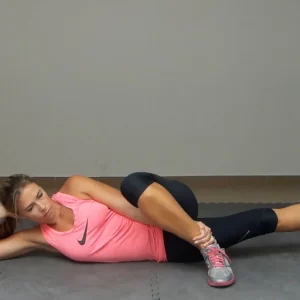
Straight leg raise
- Your legs should be comfortably spread out on the floor as you lie on your back with your hips straight.
- Plant your foot flat on the floor and bend the knee of your non-injured leg to a ninety-degree angle.
- Your quadriceps, which are the muscles on the front of your thigh, should contract to stabilize the muscles on your straight leg.
- Raising the straight leg a few inches off the ground, take a deep breath.
- Hold this position for a few seconds.
- With control, release the breath and drop the leg to the ground.
- Then return to your neutral position.
- Then relax.
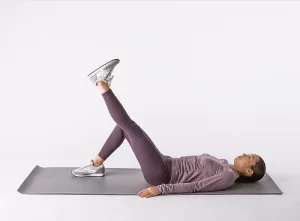
Lateral squat
- With your arms by your sides, toes pointed forward, heels firmly planted on the ground, and your feet spaced three to four feet apart, take an upright posture.
- As you put weight into your right hip and push your hips back, bending your right knee, imagine yourself sitting in a chair.
- Keep your left leg straight and your chest upright.
- Put your hands together in front of your chest while you relax.
- As far as your range of motion permits, lean.
- The left leg’s inner thighs should stretch, and the right leg’s glutes, hamstrings, and inner thighs should all feel activated.
- Keep your right knee from going past your toes.
- When your range of motion is at its maximum, push through your right foot to get back to the starting position.
- Then relax.
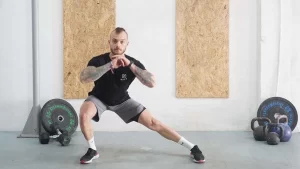
Leg swings
- The individual is positioned with their feet shoulder-width apart.
- Next, raise your right leg off the ground while maintaining your weight on your left foot’s heel.
- If the patient needs support, then grasp onto a chair or wall.
- Start this exercise slowly by swinging your right leg from side to side like a pendulum.
- First, as the muscles start to relax, try not to twist your body too much.
- However, increase your speed and swing your leg out farther with each movement.
- Then return to your neutral position.
- Then relax.
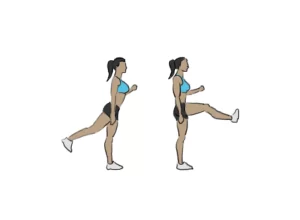
Lateral Leg Raise
- The individual will want to exercise on top while lying on the side with the hip joint.
- The patient should then be able to raise their upper leg without shaking by flexing their bottom knee and hip joint for stability.
- The upper leg must remain straight and in alignment with the trunk.
- As the individual raises their leg straight up toward the ceiling, contract their abs to support hip stability.
- Hold this position for a few seconds.
- Then lower your leg gently.
- Then return to your neutral position.
- Then relax.
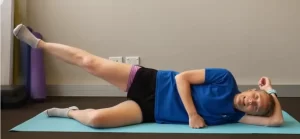
Balance Pad Marching
- With their feet hip-width apart, the patient should be standing.
- If they wish to test their balance, they can attempt stepping onto a foam pad designed for balance.
- Alternately put your weight into one leg and elevate the other, bending your knee and raising your thigh toward the ceiling.
- For ten to fifteen reps on each leg, repeat and switch.
- Then return to your neutral position.
- Then relax.
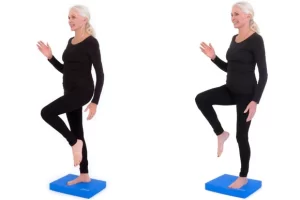
Standing Hip Extension with Loop Band
- The patient is standing close to a wall or chair to maintain balance.
- Before beginning to exercise, tighten your abdominal muscles and maintain a straight posture while surrounding your legs with a loop band just above your ankles.
- Afterward, place the weight on the right leg initially, raise the left leg until the foot clears the floor, and extend the leg back straight.
- Do not lean forward or arch your lower back.
- Next, concentrate on tense the gluteal muscles; if necessary, decrease the range of motion (ROM).
- When you’re ready, switch to the other leg and repeat this exercise on the other side.
- Then return to your neutral position.
- Then relax.
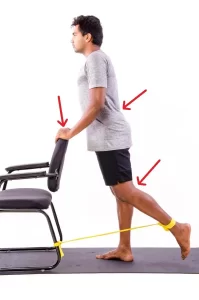
Squats
- Toes turned slightly out, place your feet a little wider than hip-width apart at the beginning.
- As you push your hips back, contract your abdominals and return your weight to your heels while maintaining an outward-facing body and stable foot pressure.
- Once your heels start to rise off the ground or your body starts to round or flex forward, lower yourself into a squat.
- To get back to your starting posture, push through your heels with your chest out and your core tight.
- Tighten your glutes at the highest point.
- Then relax.
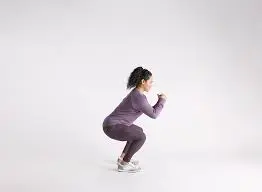
Risk factors for thigh pain:
There are various reasons for thigh pain, each associated with a risk factor.
These factors include;
- Diabetes and Pregnancy
- If you engage in regular activity, such as walking or jogging
- In case you are obese and overweight
- Poor flow of blood
- If you participate in sports
- History of hip and leg injuries
- If the patient has a history of chronic conditions like diabetes or rheumatoid arthritis
Preventing pain in the thighs muscles:
- Prescription medicine and regular use of compression garments are two methods of prevention when thigh pain is caused by deep vein thrombosis (DVT).
- Maintaining a healthy weight is your goal.
- It is usually recommended to stretch following an exercise.
- Throughout the workout, always perform the warm-up and cool-down.
- Avoid prolonged sitting by including regular physical activity in your daily routine.
Summary
Walking, running, or climbing stairs may be tough for you if you have thigh pain. Upper or inner thigh pain can occasionally follow trauma or an injury. In other situations, it could start for no obvious reason at all.
Any type of thigh injury can cause severe pain and make daily activities challenging. Using heat or cold, taking painkillers, or attending physical therapy are some possible treatments, depending on what is causing the issue.
FAQ
Is walking an effective way to relieve thigh pain?
Walking and other aerobic exercises are beneficial for painful thigh muscles. Take a walk on a day off. It maintains optimal blood flow to the muscles and encourages recovery.
Why do muscles in the thighs hurt?
Tendon irritation may result from overusing and repeatedly stressing your thigh muscles. Tendonitis is the name given to this illness. The front or back of your thigh, usually in the area of your knee or hip, may hurt if you have quad or hamstring tendonitis.
What is the duration of thigh muscle pain?
For a small strain, this can take up to 3 weeks, and for an acute strain, such as a hamstring strain, it can take up to 6 months.
How significant is thigh pain?
People with this condition may experience pain and anxiety, even though thigh pain is normally not considered a severe concern. The following are a few typical risk factors: having a sedentary way of life. lack of exercise, or similarly, excessive and repetitive exercise.
How can muscle pain in the thighs be relieved?
Musculoskeletal pain can be effectively managed with the use of heat or ice. Ice is especially helpful if you have an injury-related thigh issue. If there is no swelling and your symptoms are not connected to a recent accident, you can try using heat to reduce your pain.
How can I treat my thigh muscle pain at home?
Recovering Weak Muscles.
Compression.
Elevation of the Affected Leg.
Heat and Ice.
The Cream-Based Solution.
Give the tissues a massage.
Do thigh pains arise from stress?
A closer examination reveals that those who experience high amounts of stress also experience tense muscles. Leg soreness could result from this prolonged stress in the legs being achy. The soreness and tightness of muscles that result from stress can also produce pain.
My thighs hurt at night; why is that?
Excessive physical activity, extended standing, or protracted sitting in an uncomfortable posture can all contribute to your legs feeling exhausted and acting up at night. Leg pain can also result from over-sedentary lifestyles.
What is the cause of the upper thigh nerve pain?
Nerve pain or injury, such as peripheral neuropathy or meralgia paresthetica, can cause upper thigh pain.
My thigh feels numb; why is that?
While meralgia paresthetica, PAD, and pinched nerves are among the potential reasons for thigh numbness, they are not usually alarming. Making behavioral changes, such as reducing weight or dressing looser to encourage blood flow, can help alleviate thigh numbness.
Do thigh pains go away on their own?
People can frequently relieve the symptoms at home, and outer thigh pain may go away on its own. However, you should see a doctor for a diagnosis and treatment plan if the pain continues.
References:
- Felman, A. ( 2018-11-28). Why am I experiencing upper thigh pain? The causes are listed in article 3210001 on Medical News Today.
- D. Rupapara (2023, Dec. 13). The causes, symptoms, treatments, and exercises of thigh muscle pain. Mobile Clinic for Physiotherapy. https://mobilephysiotherapyclinic.in/thigh-muscle-pain/
- J. R. Evans (2023, June 27). An upper thigh pain. Pain in the upper thigh: Healthline. https://www.healthline.com/health
- March 1, 2024; Pt, B. S. Reasons for Lower Back Pain and When to Consult a Physician. Verywell Medical Center. Treatment for thigh pain causes and symptoms: https://www.verywellhealth.com/417443
- Image 3, Online store 119543815 (n.d.). [119543815.html] at https://senicessm.live/product_details.
- Image 5, On July 22, 2019, Brilliant, J., and Brilliant, J. Four Hamstring Stretches for Professionals at the Office. Superb Skin & Massage TM. https://jolitabrilliant.com/office-professionals/5-hamstring-stretches/
- Image 9, Strap-based Prone Quad Stretch for [P]rehab (2021, July 15). [P] Recovery. The prone-quad stretch strap can be found at https://library.theprehabguys.com/vimeo-video/
- Image 11, Butler (2017) 21 December. Stretch of the month: Revival massage through the crossover stretch. massage for revival. This is the crossover stretch: https://revivalmassage.co.nz/
- Image 12, August 21, 2017: Grey, J. Easy mobility exercises and hip adductor stretches. My Rehabilitation Association. Adductor stretches: https://myrehabconnection.com/
- Image 18, A. (2021, June 18). How to Perform Hip Exercises While Lying Down. Exercises for the hips that involve side laying are available at PhysioFit Health.
- Image 19, On March 30, 2022, Pinkham, H. Seven Balance Pad Exercises for Seniors. Seven senior-friendly balance pad exercises, from ProsourceFit. https://www.prosourcefit.com/blogs/news
- Image 20, Hip extension while standing using a theraband. (December 11, 2020). Vissco Private Health Inc. This exercise involves standing up and extending your hips using a theraband.

